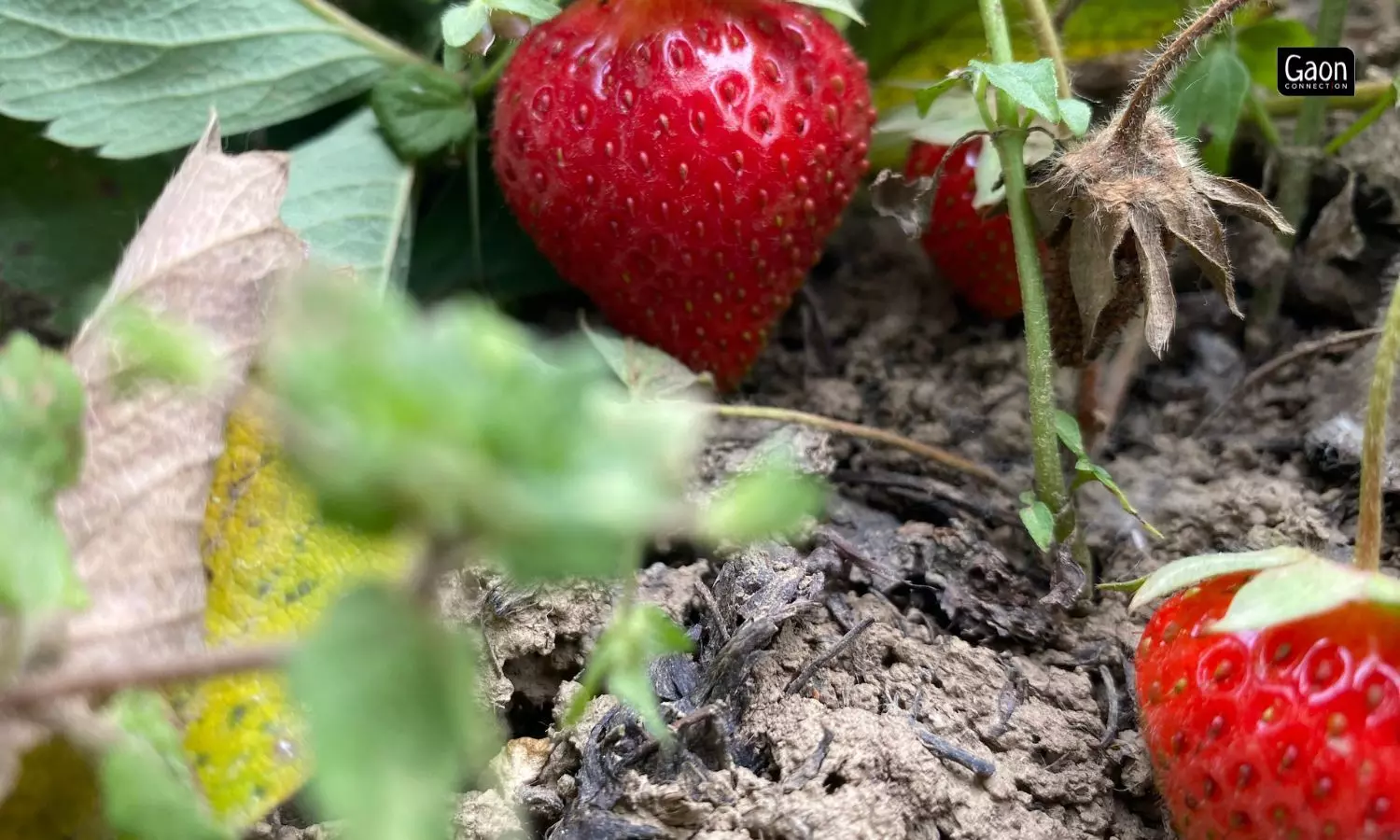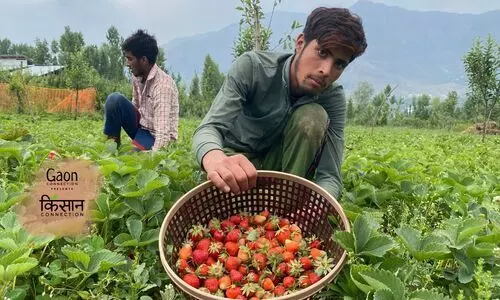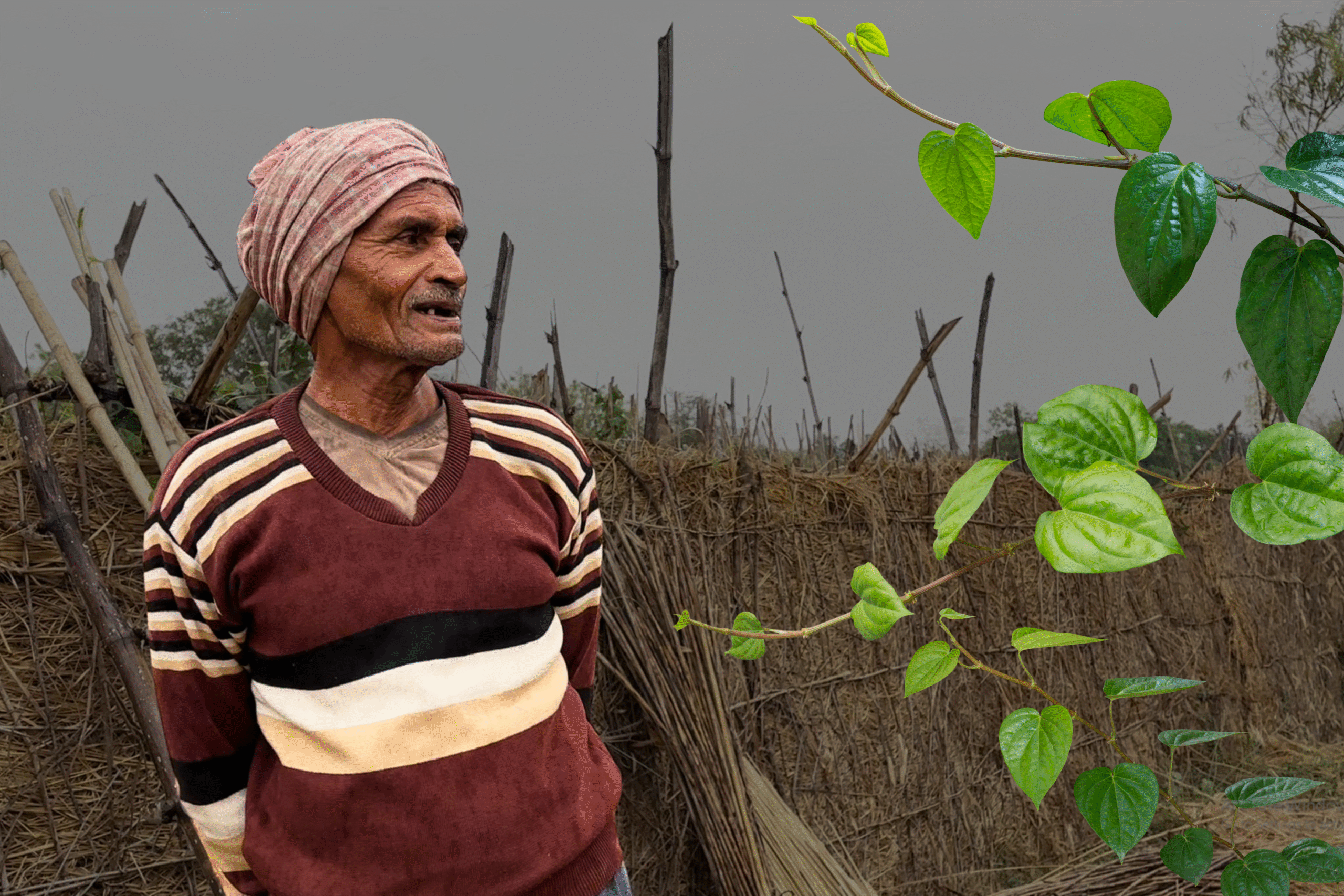Gaasu (Srinagar), Kashmir
Gaasu village is nestled in the valley surrounded by breathtaking mountains, snow-capped peaks, and picturesque landscapes. The village is scattered with traditional wooden houses with sloping roofs to withstand the heavy snowfall during the harsh winters in Kashmir.
One of the prominent features of Gaasu village, which lies on the outskirts of Srinagar in Jammu & Kashmir, is its fruit orchards and strawberry farms.
Ali Mohammad and his wife Sara Begum are small-scale strawberry farmers in this village. During the harvest season between the end of April and May, they head towards their strawberry patch of two kanals (0.25 acre) and begin the delicate task of plucking the strawberries.
Like them, 1,000 families in Gaasu are involved in strawberry cultivation, and the village is also known as the ‘Strawberry Village’ of Kashmir. But this year, strawberry farmers like Mohammad face the possibilities of a bleak harvest.
Untimely, heavy rainfall in March and April, the spring season, have caused considerable damage to the berries, complain strawberry farmers.
“We have suffered about 30 per cent losses,” complained 60-year-old Hameed Mir, a seasoned strawberry grower from Gaasu. “Just when the farmers were anticipating a bumper crop, the untimely rains before the harvest period dashed their hopes,” he said.
Also Read: The Strawberry Farmers of Darjeeling Stranded with a Sour Harvest
Thunderstorms and hailstorms in March and April disrupted the strawberry cultivation, leading to damaged crops, which is confirmed by the weather department.

Untimely, heavy rainfall in March and April, the spring season, have caused considerable damage to the berries, complain strawberry farmers.
“This year, we have experienced an unusual pattern with frequent western disturbances, resulting in above-normal rainfall during April and the first ten days of May,” Sonam Lotus, director of the Meteorological Department, Srinagar, told Gaon Connection.
“Srinagar and Qazigund received 146 mm and 167 mm of rain in March, much more than the normal 91 mm and 116 mm respectively,” the official said.
The Strawberry Village of Kashmir
“Due to its favourable climate, Gaasu has been an ideal place for this delicate crop. Although strawberries are also harvested in Tangmarg in the north and in some regions of South Kashmir, the fruit from Gaasu is recognised for its bigger size, exquisite taste, and juiciness,” Aquib, a 27-year-old farmer from Gaasu, told Gaon Connection.
“I have been cultivating strawberries for several years now, and I have witnessed the transformation it has brought about to our village,” said Manzoor Ahmad, a prominent strawberry grower from Gaasu village.
According to him, strawberry production began in earnest in their village about fifteen years ago. Before that strawberries were grown in the Harwan and Dara areas.
Also Read: Strawberry Brings Sweet Tidings to Bundelkhand Farmers
“Before we began strawberry cultivation, we grew rice on our land. On my 4.6 kanals of land alone, I am able to produce around 3,000 kilograms of strawberries,” said Manzoor.
“However, while initially we thought this year was going to be a promising one for the strawberries, consistent rainfall followed by a heatwave in March and rains in April has resulted in substantial damage to our crops,” the farmer added.
The strawberries from Gaasu are taken to the Parimpora mandi in Srinagar, from where they are distributed to other mandis in Kashmir. “Last year, we also sent strawberries to Punjab, Delhi, and Jammu with the help of cold storage vans,” said Manzoor.
Poor weather affects strawberry harvest
According to Lotus, in April and May due to the transitional period between winter and summer, the temperatures gradually rise and occasionally reach 30°C. The convection processes lead to the development of local microscale weather phenomena, such as thunderstorms and hailstorms.
“These weather events pose a threat to agriculture, plants, and apple trees, causing damage to crops and the livelihoods of the farmers,” said the weather official. The met department had provided impact-based early warnings to allow farmers to take necessary precautions, he added.
But farmers have still suffered losses. “We have heeded the warnings from the meteorological department and taken preventive measures. However, despite our best efforts, there has been substantial damage to our harvest,” Farooq Ahmed, a strawberry farmer with one kanal of land, told Gaon Connection.
It is not just erratic weather patterns that has caused the strawberry farmers grief. It is also a lack of administrative support, they complain. Strawberries are extremely perishable and have a short shelf life.
Also Read: Strawberries sweeten the labourer-landowner bond in Uttar Pradesh’s Barabanki
“Last year, I appealed to the administration to provide refrigerated vans for the farmers to transport strawberries to other states as well. They provided us with cold storage vans last year, but we are yet to receive the vans this year, and the shelf life of the fruits is limited,” worried Manzoor.

It is not just erratic weather patterns that has caused the strawberry farmers grief. It is also a lack of administrative support, the farmers complain.
According to him, there has also been significant shrinkage of cultivation land. “Last year, 129 kanals of land in Gaasu had strawberries growing on them. This year it is reduced to only 100 kanals,” said Manzoor.
“We sell 250 grams of strawberries for not more than forty rupees in the village. But, I have seen that in the market they are being sold at Rs 70 or more. Customers benefit from receiving fresh strawberries directly from our farms. In bulk, our strawberries sell for anything between Rs 100 and Rs 115 a kilogram,” added the strawberry farmer.
Support to strawberry farmers
Strawberry farmers of Gaasu have appealed to the department of horticulture to provide necessary support to them.
Iftikar Ahmad, the district horticulture officer, observed that while the production of strawberries in the orchards at Gaasu was more this year, the rainfall had cast a pall of gloom.

Last year, the farmers also sent strawberries to Punjab, Delhi, and Jammu with the help of cold storage vans.
“In our discussions with farmers, we found that the average production from their orchards ranged from 500 to 700 kilograms per kanal, with some farmers even reporting harvests of up to 1,000 kilograms,” said the horticulture officer.
“The strawberries suffered damage, as excessive moisture from the rains led to damp and fungal infections, resulting in crop loss,” he added. “Had proper mulching been implemented, the crop damage could have been brought down,” he said.
Also Read: The Strawberry Farmers of Odisha
According to Iftikar Ahmad, the horticulture department in Kashmir supports the farmers in several ways. “Our objective is to motivate farmers to diversify their crops rather than relying on a single crop,” said the official.
Besides strawberries, the horticulture department has come up with two schemes to increase the area of cultivation of other fruits too.

Strawberry farmers of Gaasu have appealed to the department of horticulture to provide necessary support to them.
“The first scheme is the Modified High-Density scheme, where we provide 166 saplings of apples, cherries, apricots and walnuts and a budget of two lakh rupees per kanal. This scheme offers a 50 per cent subsidy and includes components such as drip irrigation systems and hail netting,” said Iftikar Ahmad.
“The second scheme is the Medium-Density scheme, where we provide 47 apple plants per kanal. In this scheme, we offer an 80 per cent subsidy, and Rs 150 per plant is credited into the farmers’ accounts. They can later purchase more plants at a subsidised rate of Rs 80,” the official added.
The horticulture department also provides subsidies for plums, cherries and walnut saplings, said the horticulture department official.




















